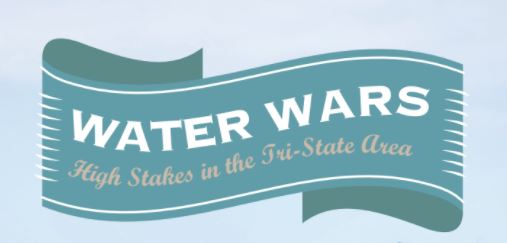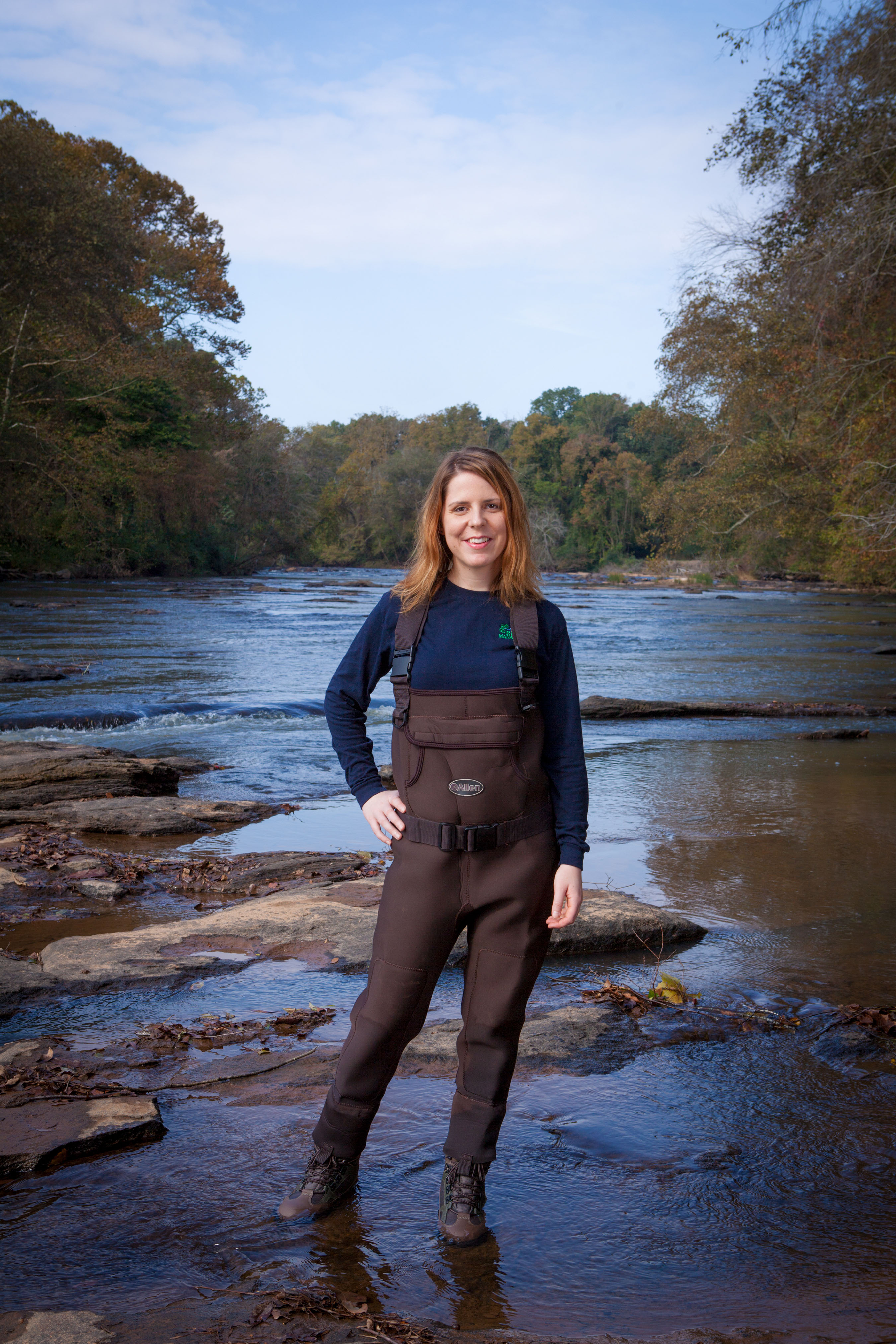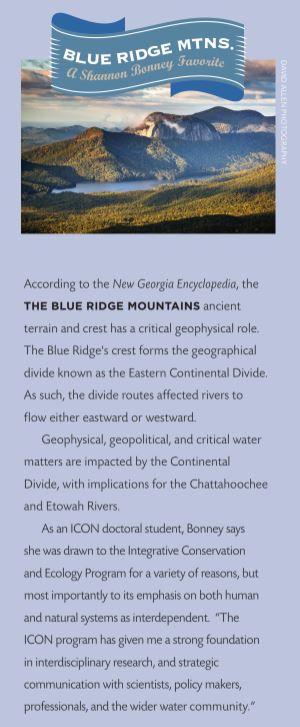Water Wars: High Stakes in the Tri-State Area, Shannon Bonney Wants to Soothe the Waters and Become Part of the Solution

By: Cynthia Adams | Photos by: Nancy Evelyn
Shannon Bonney has worked with the ACF Stakeholders Group since beginning graduate studies at UGA in 2010. Although their name may suggest a racehorse cartel, that would be wrong. This consortium concerns a vital resource, and the stakes are high and growing. The ACF represents the Apalachicola-Chattahoochee-Flint basin. Shannon Nichole Bonney is the most affable of environmental warriors, and her mission is to help negotiate a high-stakes matter: water rights.

Shannon Nichole Bonney on river shoals (Middle Oconee River)
To the outer world, the raison d’etre for a tri-state group drawn from Georgia, Alabama, and Florida is to mediate an agreement for better water management. The involved players – governmental, educational, policy makers, environmental stewards and volunteer figures—have been at the core of a “water war”–a term graduate student Shannon Bonney winces over and dislikes. In fact, when the term, “water détente” is suggested, she moans and shakes her head no.
“Please keep any war terminologies out,” she says. The factions, these previously warring factions who could not come to terms with teams of litigators in court, are now friendly foes, according to Bonney. She says the stakeholders are finding another, better way, to make resource policy.
The intra-state dispute has been ongoing since at least 1990, according to the International Business Times. The three states of Georgia, Alabama, and Florida are affected by the AFC water basin, which is largely regulated by the Army Corps of Engineers. By the late 1990s, there were agreements brokered between Alabama, Florida, and Georgia—each impacted by the Apalachicola-Chattahoochee-Flint basin. And there was an agreement negotiated between Alabama and Georgia who share the ACT basin, the Alabama-Coosa-Tallapoosa.
The news, however, has been and continues to be, worrying. According to the Southern Environmental Law Center, or SELC, the states have now been battling over water resources for nearly 20 years—and counting.
In June of 2013, Robert Kennedy Jr., president of the Waterkeeper Alliance, visited Georgia concerning the water usage conflict. Kennedy argued that the implications were larger than regional, affecting water issues hundreds of miles away in the Gulf of Mexico.
“When Atlanta and the state of Georgia and Alabama and Florida struggle over competing claims to the water flows, we have to also consider the impacts on the aquatic ecosystem, not just for the sake of the oysters and fisheries… but also for the human populations and the giant economic engines,” Kennedy implored.
While two major river basins affect all three states, Georgia has first dibs geographically. The stakes for all concerned grew greater as Atlanta’s population swelled, eclipsing the growth of other Georgia cities. According to the 2010 United States Census, Atlanta’s population was 420,003. Also, a severe, historic drought situation in 2007 gripped Atlanta, which intensified matters, and during which there were mere days of adequate water supply remaining.
“As the upstream user, Georgia wants to have enough water to continue growing,” SELC points out. Therein lies the problem. By 2008, the Tri-State Conservation Coalition submitted a brief in federal court to intercede on behalf of Alabama and Florida.
A drought contingency plan for the affected river basins has recently been under review by the Army Corps of Engineers.
Downstream users, Alabama and Florida, are worried about how that has affected their power generation and fisheries. At the last stop, where the basins ultimately reach the ocean, the reduced flow of fresh water dramatically impacts their shellfish industry in the formerly shrimp and oyster-rich Apalachicola Bay. Oyster farming and shrimping is so threatened that operations are shutting down in historic numbers. Generations-old oyster harvesters entreated lawmakers for help as recently as this past summer
The International Business Times describes poignant demonstrations by fishing families and political demands by Florida lawmakers. Semantics may matter to peace-making mediators, but whether you call them water wars, battles, skirmishes or disputes, the Byzantine problems of fair water usage policies remain headline news. The ACF stakeholders are among the only groups that have stepped away from litigation—and the limelight.
For Bonney, a tireless environmental volunteer and now University of Georgia doctoral student, that is their particular strength. She calls their efforts “monumental.” She began working with ACF two years into the process, and draws inspiration from the ACF’s consensual work.
“The ACF stakeholders are a group that started meeting, I would say, five years ago. It is composed of the water managers, water people, planners, the industry—the full spectrum. They formed as a way to work together after the failed lawsuits. They wanted to figure a better way than sitting in courtrooms.” ACF called for a sustainable, equitable water plan to be crafted with stakeholders doing the crafting.
“The idea was to take hydrologic models, water use demands, and climatic models, and put everything together and find a plan everyone could live with,” Bonney says. The new trend is consensus-building she adds. “We meet in a different part of the basin each quarter, in order to experience the entire basin.”
Early October of 2013, the ACF stakeholders met at Unicoi State Park, a mountainous, green, undeveloped area in northern Georgia that is popular with hikers. Bonney and others addressed the policy makers with intentions to move the plan forward.
“There are people who oversee nonprofit organization, government people, etc. They have worked together to create a trust level that is unparalleled.”
For Bonney, the unspoiled beauty of Unicoi was close to her first southern home in Asheville, N.C. The Blue Ridge Mountains were redolent of the Green Mountains she grew up with in Vermont—the ones that indirectly landed her in a UGA doctoral program in Integrative Conservation (ICON).

Living Up to a Big Idea and Ideal
She sits with excellent posture on a squishy sofa. Not stiff, just composed. With her careful grooming, red hair, caramel colored eyes, small frame, and open face, Bonney inspires, with surprising maturity, trust. And she is only 29. Here’s the thing: Despite the fact that Bonney is going after a doctorate with the same vigor that others might run a 5K, or away from a rabid dog, she gives a friendly vibe right from the get-go. She falls into conversation, especially environmental ones, easily. Intense. Smart. Refl ective. All those adjectives apply, as Bonney listens, pauses, nods her head, and then shares.
She may fit the earnest stereotype for a statistics crunching researcher, yet Bonney likes engagement with others, and a description of her work and career goals is punctuated with laughter.
Her blended family is still in New England, though some have now migrated to Georgia. And, fitting another stereotype, Bonney is the typical, driven eldest child, with seven younger siblings. Her father, she says, is business-oriented. Her mom is an artist. She negotiated between the two poles and feels practical and yet visually moved by natural beauty.
Growing up in the mountains of Vermont, she observed the natural world influenced by her artistic mother. She also recognized disturbing changes.
“I do think I got into natural resources by having grown up in such a beautiful area. It was such an important part of my childhood. Watching unrestrained, unplanned development, I see how quickly it can turn into something not so natural and not so beautiful. Planned development is very important to have the best of both worlds.”
So when Bonney says that she loves being outdoors and the natural world, and then when her major professor, Laurie Fowler, suggests she is the right person to talk to concerning water issues of the present day, it is immediately clear why.
“Shannon quickly became key in our work identifying options for sustainable transboundary water management in the Apalachicola-Chattahoochee Flint,” says her advisor, Laurie Fowler. Fowler, an associate dean of administrative affairs in the School of Ecology, is also director for policy and managing director of UGA’s River Basin Center.
“She helps coordinate students and faculty in six southeastern universities who are part of this effort, conducts cutting edge research by interviewing executive directors of transboundary institutions across the globe to identify successes and pitfalls and serves as first author on our summary report, helps define future research efforts and presents much of our work to our stakeholder clients. Nothing fazes her as she throws herself into this major issue— water wars—that will become more relevant around the world as a result of competing water uses and changing climate!”
When Bonney is asked what her Big Idea is, as in why her work fits with the theme of this issue concerning Big Ideas, she doesn’t miss a beat.
“My big idea,” Bonney firmly answers, “is we need a much bigger place for planning and collaboration. We have huge issues to tackle; but real good planning will get us through. It might be the optimist in me that we can tackle these things and be hopeful for the future.”
She talks as quickly as a fast typist can type. Actually, she talks faster than 65 words per minute. “It’s sometimes hard to keep your morale up, but if you look for examples of people making positive change it is easier to keep your optimism.” As an undergrad at Green Mountain College, she did a project on civic engagement. She says she looked at civic engagement and how sustainability relates, and she leaves no doubt she was ever anything less than a serious student.
“The understudy part is, what does it mean to have a community you are part of, and involved in? The decline of civic engagement came with the rise of technologies.” Now that we have the ability to socialize only with our peers, in our same interest groups, she says we select interests and others who mirror ourselves. “Whereas before you were connected with people who had different points of view.”
She says that different points of view are necessary and healthy. In fact, Bonney has been so entrenched in the concept of making differing voices part of a cohesive whole that this premise is quickly becoming the centerpiece of her work.
“My project is a very regional, local project. I’ve always been driven to get involved with a community. I chose the conflict over water between Georgia/Alabama/Florida. When I came in, I was lucky to work with Laurie Fowler. She is connected with the River Basin Center at UGA, and studies water issues in a practical way.”
How has Bonney’s all-consuming ACF research affected her doctoral focus? All for the good, she says.
“It has been great to get to know the water community in a way I otherwise couldn’t have,” Bonney replies. The relationships she has made through ACF have provided a framework for her dissertation research. She explains her dissertation title, which is a mouthful, but reflects consensus and policy-making in managing natural resources. “I’m searching for a non-jargony way to say it,” she grins, and regroups.
Bonney may not have finalized her dissertation title, but she knows her topic. It is, basically, the culmination of everything that attracted her from early days hiking and swimming in Vermont. She self-corrects: “Sustainable agricultural systems. I studied agro-ecological systems, with no pesticides, at Green Mountain College in Vermont.”
She says that while growing up in New Hampshire and Vermont, she made the decision to move further south even before selecting a graduate school. “I never liked the cold,” she confesses.
Her fascination with the natural world began in her childhood, when she says she swam in waters near the Green and White Mountains whenever possible. Those beautiful mountains fed streams, Bonney says reflectively. “I spent every day in the water, and didn’t think about it…just a personal connection to rivers, water.”
In her first job after getting a bachelor’s degree and spending a year abroad, she went to work for the Agency of Natural Resources in Rutland, V.T. “I was in departmental conservation and the river management program in Rutland in 2006 and 2007.”
The department offered to extend her employment, but Bonney sought change. She made the move south alone. “I knew from previous trips that North Carolina and Asheville were a great place and I decided to move there. I chose Asheville because of the mountains, and I wanted a place offering (alternative) culture and food.”
Bonney trained as a sous chef in an Asheville restaurant for a while. She worked with the local foods movement and was a vegetarian for about 10 years. “I explored the ethics of it, then decided eating meat sourced from local farms was probably a good thing.”
She flung herself into supporting local agriculture and farms. During her free time, she trained and worked with Asheville volunteers sampling water quality. “When something starts to affect you directly, then people get involved,” she observes.
Through the North Carolina Adopt-A-Stream program Bonney grew more concerned with water issues. “It’s called ‘Citizen Scientist’, and by other names. They train you on chemical and biological monitoring, and if you pass the test, you pick a stream and collect data for it. We gave data to the organization, and if the data was good they gave it to their state version of the EPA.”
She discusses drought/paucity, and the opposite: unlimited access to water. Bonney had become intensely interested in varying perspectives on water, which seemed dependent upon access. She says it is often hard to understand we are not above or beyond water shortages. “Here in the South, we have riparianism. The riparian law applies to equity in usage.”
She became fascinated with Athens while living in Asheville. “I looked at research coming out of the School of Ecology. Eugene Odom is a huge figure within ecology. I was drawn to UGA because of this…I knew I wanted to work with policy makers, projects, and sustainability.”
Asheville, another rapid-growth region, has become wildly popular with retirees, and is often listed as a top retirement destination. The town was profiled on CBS in the newsmagazine “Sunday Morning” for its unusually thoughtful approach to urban growth. When she got into UGA, Bonney first did a project concerning integrative conservation and steep slope development. Steep slope development is a hallmark of Asheville and surrounding mountainous areas. It is famously complicated for community-building and accessibility.
Bonney is now in her third year of doctoral study and working full time on her research under the tutelage of Fowler, through the River Basin Center.
“Fowler has a great track record, working with students and connecting them with the local community,” says Bonney. “She had a huge laundry list of projects. When I heard about the multi-state project, I jumped in and I’m still working with it.” She says she is drawing from other basins for her research. “There’s real connection between ecosystems, humans, and a lot of momentum…balancing these things in this basin presents so much opportunity, to the highest levels of government…working towards better and new ways to manage the watershed and explore my interests in a way that would be helpful.”
The institutions that manage water across state boundaries have inherent difficulties. Bonney says that in order to balance the tradeoff between ecosystem health and economic prosperity, they must balance protection of natural resources. “But,” she notes, “doing so through an institutional lens.” There are many minefields to navigate in making water policies feasible. One is environmental flow.
Environmental flows, she explains, is a new term for water left in streams for the sake of ecosystem health. “A lot of states have minimum flows to protect environmental life. This goes one step further to look at pulses of flows. How is that different? The field of environmental flows is a new field. In addition to minimum flows it would also be an additional layer such as pulses of water in the spring for spawning for fish…you can easily get into the weeds.”
And there are other minefields. “How does it affect recreation and hydropower, for example. And, can we have a dialogue about the quality of water we are using?”
The issues are not germane only to the tri-state area, Bonney reminds. “The Chesapeake Bay has been looking at their water quality for more than a decade.”
But they differed, in that within the ACF basin, drought was the more pressing problem. “However, if you look within the basin, water quality issues are being addressed.” She mentions the Atlanta area, which is a big, multi-county area, with layers of government. “What they have been doing is to try and tackle these water quality issues head on. They are a good example of addressing water quality issues.”
In the years ahead, in two and a half years or so when Bonney completes her doctorate, she sees herself still working on water-related issues, ideally in a planning position. She has developed a great love for the basin and the area—and for her, the way they have been parsing out a solution has been endearing and inspiring. For the average person, Bonney says, there are ways to be part of the solution, and she likes that.

Water hose at horticulture farm in Watkinsville
Water at Risk: Identifying the New Culprits
Protecting our water supply seems intuitive. According to environmental protection entities ranging from the EPA, Riverkeeper, and Nature Conservancy, this is not quite the case.
When historic droughts occur, attentions naturally turn to water. But in the absence of drought, attentions fade. Yet in 2013, the U.S. continues to experience water shortages. The General Accounting Office issued a report a decade ago predicting 36 states would clearly suffer.
Organizations report myriad issues putting water at risk. Droughts, poor water management, and chemical contamination are causes. Flushed drugs, such as antibiotics and antidepressants, commonly are detected in water supplies. Fluoride is a controversial additive, which is considered by some scientists as a toxic fumigant.
Bonney says, “Risks to drinking water come in many forms, such as municipal and industrial discharges, recreational activities or simply natural conditions and events. These can all, in one way or another, be considered a risk to the safety of our drinking water.”
In an ideal situation, there is adequate, clean water for all. According to the EPA, the average household uses 94,000 gallons of water annually—and the number of households rises annually. So does consumption.
According to Bonney and others, a looming problem is dealing with non-point source pollution.
“We used to deal with a point source, for example, factories, etc. The EPA tackled that. There is a growing problem with non-point pollution; it is much harder to tackle. Every person plays a part in this.”
Cooking grease is a lesser known culprit. “Cooking grease has a huge impact on water quality—it clogs the water treatment plants. Athens Clarke County built a new sewage plant and already came to ask about how to deal with the grease. It makes the problem so much more difficult to address, but it gives the average citizen the chance to become part of the solution. Another problem is people not maintaining their septic tanks—then it infiltrates the streams—then E. coli can enter the water supply.”
In photographs taken from space, we can see that our planet has more water than land. Less than three percent of Earth’s water is fresh water. According to the U.S. Geological Survey, most of that three percent is inaccessible. Only about 0.3 percent of our fresh water is found in the surface water of lakes, rivers, and swamps. Of all the water on Earth, more than 99 percent is unusable by humans and many other living things! It seems extraordinary that the water that supports all terrestrial, as well as aquatic, life on our planet is actually so scarce. With this stunning realization comes a recognition that we have to utilize this resource very wisely.








